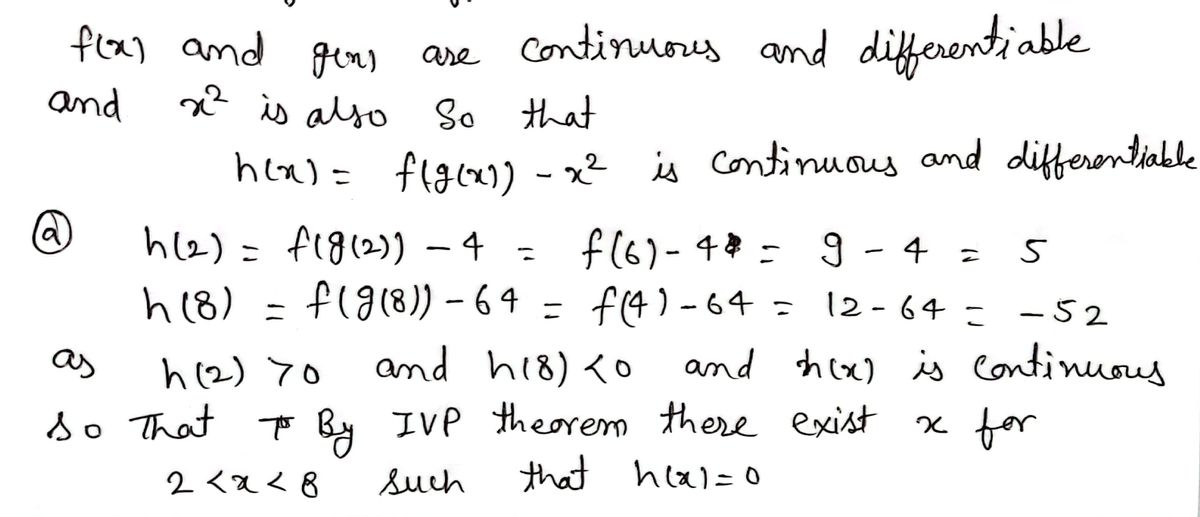The functions f and g are continuous and differentiable for all values of x. The continuous function h(x) is given by _h(x) = f(g(x)) — x². The table at the right gives values of f(x), f'(x), g(x), and g'(x) at selected values of x. X f(x) f'(x) g(x) 2 38 0 6 -3 a. Explain why there must be a value x for 2 < x < 8 such that h(x) = 0. b. Show that there must be an x = c, 4 < c < 6, such that h'(c) = 0. 4 12 9 8 -4 6 9 -5 2 6 8 18 12 4 3
The functions f and g are continuous and differentiable for all values of x. The continuous function h(x) is given by _h(x) = f(g(x)) — x². The table at the right gives values of f(x), f'(x), g(x), and g'(x) at selected values of x. X f(x) f'(x) g(x) 2 38 0 6 -3 a. Explain why there must be a value x for 2 < x < 8 such that h(x) = 0. b. Show that there must be an x = c, 4 < c < 6, such that h'(c) = 0. 4 12 9 8 -4 6 9 -5 2 6 8 18 12 4 3
Advanced Engineering Mathematics
10th Edition
ISBN:9780470458365
Author:Erwin Kreyszig
Publisher:Erwin Kreyszig
Chapter2: Second-order Linear Odes
Section: Chapter Questions
Problem 1RQ
Related questions
Question
The problem is attached.
![The functions \( f \) and \( g \) are continuous and differentiable for all values of \( x \). The continuous function \( h(x) \) is given by
\[ h(x) = f(g(x)) - x^2. \]
The table on the right provides values of \( f(x) \), \( f'(x) \), \( g(x) \), and \( g'(x) \) at selected values of \( x \).
\[
\begin{array}{|c|c|c|c|c|}
\hline
x & 2 & 4 & 6 & 8 \\
\hline
f(x) & 38 & 12 & 9 & 18 \\
\hline
f'(x) & 0 & 9 & -5 & 12 \\
\hline
g(x) & 6 & 8 & 2 & 4 \\
\hline
g'(x) & -3 & -4 & 6 & 3 \\
\hline
\end{array}
\]
**Tasks:**
a. Explain why there must be a value \( x \) for \( 2 < x < 8 \) such that \( h(x) = 0 \).
b. Show that there must be an \( x = c \), \( 4 < c < 6 \), such that \( h'(c) = 0 \).](/v2/_next/image?url=https%3A%2F%2Fcontent.bartleby.com%2Fqna-images%2Fquestion%2Fc6ffa477-99d7-4e93-b7f8-2eced087179b%2F0ee649fc-5ec7-420b-b143-202dbc4581cc%2F0swtai9_processed.jpeg&w=3840&q=75)
Transcribed Image Text:The functions \( f \) and \( g \) are continuous and differentiable for all values of \( x \). The continuous function \( h(x) \) is given by
\[ h(x) = f(g(x)) - x^2. \]
The table on the right provides values of \( f(x) \), \( f'(x) \), \( g(x) \), and \( g'(x) \) at selected values of \( x \).
\[
\begin{array}{|c|c|c|c|c|}
\hline
x & 2 & 4 & 6 & 8 \\
\hline
f(x) & 38 & 12 & 9 & 18 \\
\hline
f'(x) & 0 & 9 & -5 & 12 \\
\hline
g(x) & 6 & 8 & 2 & 4 \\
\hline
g'(x) & -3 & -4 & 6 & 3 \\
\hline
\end{array}
\]
**Tasks:**
a. Explain why there must be a value \( x \) for \( 2 < x < 8 \) such that \( h(x) = 0 \).
b. Show that there must be an \( x = c \), \( 4 < c < 6 \), such that \( h'(c) = 0 \).
Expert Solution
Step 1

Step by step
Solved in 2 steps with 2 images

Recommended textbooks for you

Advanced Engineering Mathematics
Advanced Math
ISBN:
9780470458365
Author:
Erwin Kreyszig
Publisher:
Wiley, John & Sons, Incorporated

Numerical Methods for Engineers
Advanced Math
ISBN:
9780073397924
Author:
Steven C. Chapra Dr., Raymond P. Canale
Publisher:
McGraw-Hill Education

Introductory Mathematics for Engineering Applicat…
Advanced Math
ISBN:
9781118141809
Author:
Nathan Klingbeil
Publisher:
WILEY

Advanced Engineering Mathematics
Advanced Math
ISBN:
9780470458365
Author:
Erwin Kreyszig
Publisher:
Wiley, John & Sons, Incorporated

Numerical Methods for Engineers
Advanced Math
ISBN:
9780073397924
Author:
Steven C. Chapra Dr., Raymond P. Canale
Publisher:
McGraw-Hill Education

Introductory Mathematics for Engineering Applicat…
Advanced Math
ISBN:
9781118141809
Author:
Nathan Klingbeil
Publisher:
WILEY

Mathematics For Machine Technology
Advanced Math
ISBN:
9781337798310
Author:
Peterson, John.
Publisher:
Cengage Learning,

